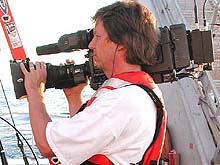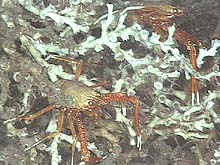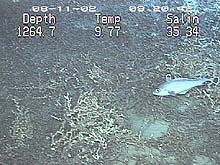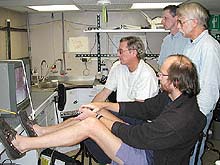
Film-maker Art Howard taking footage of samples having been retrieved by the Johnson-Sea-Link after a research dive. Click image for a larger view.
“1400-feet Down in a Washing Machine”
August 12, 2002
Art Howard
Filmmaker, Napro Communications
![]() Watch a slideshow of the organisms that the Johnson Sea-Link encounters during a research dive. (mp4, 1.5 MB)
Watch a slideshow of the organisms that the Johnson Sea-Link encounters during a research dive. (mp4, 1.5 MB)
How many days do you wake up knowing you are going to visit the floor of the Atlantic Ocean, 1,400 feet down? Today was my day. I have always been one to wonder what is around the next corner, over the next hill, or under the surface. I am always excited about discovery and new ideas. For the last week, I have sailed along the coast of North Carolina, sharing that same fascination with 20 scientist and teachers. Their objective—scientific research of deep water reefs; mine—telling their story through high definition video.
Today, my goal was to see firsthand the submersible part of this mission. What is it like to climb into a Plexiglass sphere only a little larger than an industrial washing machine and travel to parts of the earth where light does not reach? What lives in that community? Why do the scientists care about the community? Why should everyone else care?
Gathering data and samples from a submersible has become old hat for some, but for me it was the opportunity of a lifetime. Today's morning dive would take us to coral banks some 60 miles off the coast of North Carolina. You immediately become aware of the sphere in which you ride—6 feet in diameter, full of gauges, switches, emergency equipment, and supplies for five days. The only sounds are communications with the ship and the murmur of oxygen pumping in. The dive's descent was quick, past pearl fish that reflected the sub lights like firecrackers. First 600 feet, then 800 feet, then 1,200 feet, and finally, 1,400 feet. Dark quiet. I finally understood why people dive.

These galatheids, also known as squat lobsters live among the dendritic branches of the Lophelia corals. Click image for a larger view.
The coral banks were like the Blue Ridge Mountains underwater, complete with ridges, valleys and box canyons. The white coral, thousands of years old, was home to Lithodid Crabs, brittle stars, squids and octopi. Their colors, bright oranges and reds, were colors I did not expect to find this far down. The valleys of the banks were sandy. They looked like cornfields after a light dusting of snow. We saw an occasional dogfish shark, as well as blackbelly rosefish. A 4-foot conger eel poked his head out of the white coral. A 3-inch octopus meandered close by. As with every aspect of this mission, sampling is the primary focus. Multiple samples of coral were placed in the front basket by a mechanical arm without even disturbing the orange scorpionfish nearby.

This coral hake seen swimming among the Lophelia is related to the northern cod fish. Click image for a larger view.
The robotic cameras of the sub captured the sampling and the variety of species for reference in the lab later. I recorded the dive from inside the sphere using a high definition video camera, although I am not sure any recording device can capture a person’s first trip in a submersible. The sights were so amazing to this first-time diver that I did not have time to think about being 1,400 feet underwater.
With so much to look at and capture, time moves fast. Three hours flew by and it was time to surface—at 1,200 feet, the bottom disappears; at 1,000 feet, all lights out, quiet; 800 feet; and then 600 feet, all you see are the bioluminescence streaks of light flashing. It's a play on your senses that I don’t think you can duplicate anywhere else. At 20 feet, massive bubbles broil froth as the sub surfaces, 10 feet, and then 5 feet, the ship can be seen through the waves. Now the washing machine comes to life. You bounce and weave until the sub is secured by a diver, and then you are back to the R/V Seward Johnson. Three hours of absolute enjoyment, but only a very small part of this offshore research mission.

After the Johnson-Sea-Link surfaces from a dive, members of the science party gather in the dry lab to review the video footage taken. They identify the type and number of species observed during the dive. Click image for a larger view.
The scientists’ mission during this expedition is to gain a better understanding of the deep ocean as a community. Mine is to bring visitors of the North Carolina Museum of Natural Sciences a better understanding of why people do this kind of research, why it matters to us all, and the time and effort that goes into this effort.
Using the latest in high definition television equipment, I record all the action. For those not familiar with high definition video production, it is the cutting edge of digital acquisition. The camera has five times the resolution of standard video cameras, is formatted 16 x 9 for a larger viewing area, and provides clarity comparable to 35 mm film. George Lucas used the same technology for the latest Star Wars movie. This delivers an improved experience for the museum's visitors. With true digital surround sound, we can take the viewer on the ship, in the submersible, and make them feel part of the mission.
As the science party continues to dive and cast nets daily, I will capture their scientific process, which includes collecting samples, casting nets, photographing and cataloging the samples of fish and invertebrates. While the sub provides a firsthand look into the coral banks and the nets provide the samples from the midlevel columns of water, I’m here to capture the highlights and frustrations of offshore exploration. Already, the rough weather and high seas have caused delays and changes in plans. Dives have been cancelled. Nets have been pulled early, resulting in fewer specimens and few videotapes shot. But the research continues. This afternoon, someone else gets the chance of a lifetime to view the earth from 1,400 feet below the water's surface.
Sign up for the Ocean Explorer E-mail Update List.














































